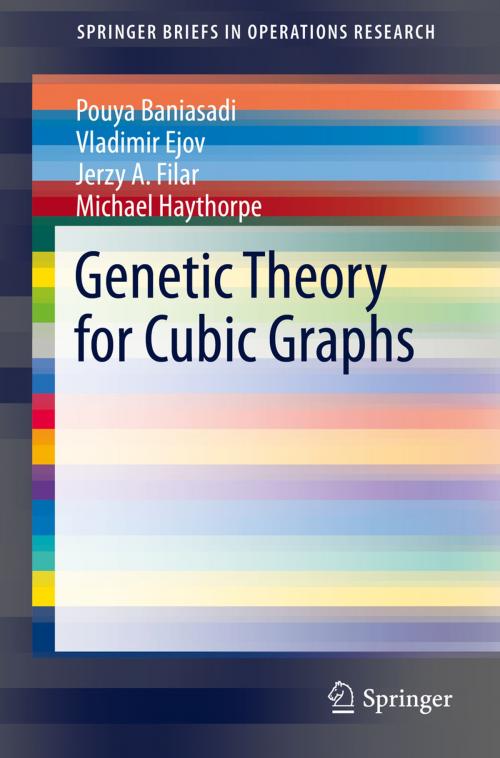Genetic Theory for Cubic Graphs
Nonfiction, Science & Nature, Mathematics, Graphic Methods, Business & Finance, Management & Leadership, Operations Research| Author: | Pouya Baniasadi, Vladimir Ejov, Jerzy A. Filar, Michael Haythorpe | ISBN: | 9783319196800 |
| Publisher: | Springer International Publishing | Publication: | July 15, 2015 |
| Imprint: | Springer | Language: | English |
| Author: | Pouya Baniasadi, Vladimir Ejov, Jerzy A. Filar, Michael Haythorpe |
| ISBN: | 9783319196800 |
| Publisher: | Springer International Publishing |
| Publication: | July 15, 2015 |
| Imprint: | Springer |
| Language: | English |
This book was motivated by the notion that some of the underlying difficulty in challenging instances of graph-based problems (e.g., the Traveling Salesman Problem) may be “inherited” from simpler graphs which – in an appropriate sense – could be seen as “ancestors” of the given graph instance. The authors propose a partitioning of the set of unlabeled, connected cubic graphs into two disjoint subsets named genes and descendants, where the cardinality of the descendants dominates that of the genes. The key distinction between the two subsets is the presence of special edge cut sets, called cubic crackers, in the descendants.
The book begins by proving that any given descendant may be constructed by starting from a finite set of genes and introducing the required cubic crackers through the use of six special operations, called breeding operations. It shows that each breeding operation is invertible, and these inverse operations are examined. It is therefore possible, for any given descendant, to identify a family of genes that could be used to generate the descendant. The authors refer to such a family of genes as a “complete family of ancestor genes” for that particular descendant. The book proves the fundamental, although quite unexpected, result that any given descendant has exactly one complete family of ancestor genes. This result indicates that the particular combination of breeding operations used strikes the right balance between ensuring that every descendant may be constructed while permitting only one generating set.
The result that any descendant can be constructed from a unique set of ancestor genes indicates that most of the structure in the descendant has been, in some way, inherited from that, very special, complete family of ancestor genes, with the remaining structure induced by the breeding operations. After establishing this, the authors proceed to investigate a number of graph theoretic properties: Hamiltonicity, bipartiteness, and planarity, and prove results linking properties of the descendant to those of the ancestor genes. They develop necessary (and in some cases, sufficient) conditions for a descendant to contain a property in terms of the properties of its ancestor genes. These results motivate the development of parallelizable heuristics that first decompose a graph into ancestor genes, and then consider the genes individually. In particular, they provide such a heuristic for the Hamiltonian cycle problem. Additionally, a framework for constructing graphs with desired properties is developed, which shows how many (known) graphs that constitute counterexamples of conjectures could be easily found.
This book was motivated by the notion that some of the underlying difficulty in challenging instances of graph-based problems (e.g., the Traveling Salesman Problem) may be “inherited” from simpler graphs which – in an appropriate sense – could be seen as “ancestors” of the given graph instance. The authors propose a partitioning of the set of unlabeled, connected cubic graphs into two disjoint subsets named genes and descendants, where the cardinality of the descendants dominates that of the genes. The key distinction between the two subsets is the presence of special edge cut sets, called cubic crackers, in the descendants.
The book begins by proving that any given descendant may be constructed by starting from a finite set of genes and introducing the required cubic crackers through the use of six special operations, called breeding operations. It shows that each breeding operation is invertible, and these inverse operations are examined. It is therefore possible, for any given descendant, to identify a family of genes that could be used to generate the descendant. The authors refer to such a family of genes as a “complete family of ancestor genes” for that particular descendant. The book proves the fundamental, although quite unexpected, result that any given descendant has exactly one complete family of ancestor genes. This result indicates that the particular combination of breeding operations used strikes the right balance between ensuring that every descendant may be constructed while permitting only one generating set.
The result that any descendant can be constructed from a unique set of ancestor genes indicates that most of the structure in the descendant has been, in some way, inherited from that, very special, complete family of ancestor genes, with the remaining structure induced by the breeding operations. After establishing this, the authors proceed to investigate a number of graph theoretic properties: Hamiltonicity, bipartiteness, and planarity, and prove results linking properties of the descendant to those of the ancestor genes. They develop necessary (and in some cases, sufficient) conditions for a descendant to contain a property in terms of the properties of its ancestor genes. These results motivate the development of parallelizable heuristics that first decompose a graph into ancestor genes, and then consider the genes individually. In particular, they provide such a heuristic for the Hamiltonian cycle problem. Additionally, a framework for constructing graphs with desired properties is developed, which shows how many (known) graphs that constitute counterexamples of conjectures could be easily found.















